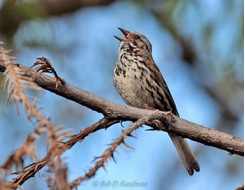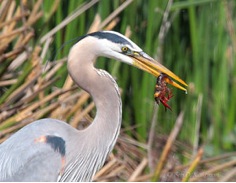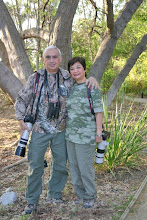skip to main |
skip to sidebar
Cynthia had a one day seminar at Costa Mesa. We both agreed that driving back 50 miles to Pasadena and then returning in the afternoon to pick her up would be economically unwise with the price of gasoline as it was. Not to mention exhausting on my part. To pass away the waiting time I drove over to San Joaquin Wildlife Sanctuary about eight miles away from the hotel where she was attending the seminar. The sanctuary would be a perfect place for me to further my skills at using my 40D.
A singing Song Sparrow greeted me as I parked the Jeep. He was in the shadows so it presented an opportunity to work up on what I learned about taking photographs in such situations. Although I know the appropriate settings on different lighting conditions, only the 40D with its much more capabilities gave me the challenge to actually put into action such photographic principles.
I was soon hitting the trails and the first thing I noticed were the gnats. Millions of them! They were all gathered flying in perfect unison at the middle of the trail. And there was no way of getting around them! I walked through this cloud of tiny flying insects, flailing my arm like an out-of-control windshield wiper. I had to repeat this maneuver hundreds of times over the next four hours. The gnat clouds were present on all the trails like the plague in Exodus 8:16 (NIV).
Fortunately, birds were quite plentiful too. Tree Swallows have begun staking their claims to the many nest boxes along the various trails. I was photographing these beautiful birds when I noticed that one of the swallows perched on top of a nest box looked different. Slowly and with the stealth of a hungry predator I inched closer and closer to the odd-looking bird. It had a chestnut neck, black cap and a white forehead, unlike the glossy blue-green of the Tree Swallows. Its identification escaped me until I got home when I looked it up and discovered that I got myself a picture of a Cliff Swallow! It may not be rare but it was a lifer for me.
As I walked along Pond C, I saw some Cinnamon Teals. What made me look twice was that one of the birds was darker with a more pointy beak and a yellow streak of feathers behind the eyes. Eared Grebe in breeding plumage! I exclaimed to myself. This is one of the most strikingly colored waterbirds in spring.
Not far from Pond C rises a very tall electric tower and there perched majestically a Red-tailed Hawk. As I aimed my camera at it, it took off and proceeded to glide effortlessly above me. A chance for me to try for BIF (birds in flight) shots and see how the 40D responds. Magnificently, it turned out, as I looked at the pictures that night.
On my way back to the parking lot a Great Blue Heron, oblivious of my presence, was hunting by the side of the pond. Suddenly it grabbed a prawn and consumed it right before my appreciative eyes (and camera).
Noon and I took my lunch at a very crowded In-N-Out close to UCI. After my repast I went back to San Joaquin but the birds were probably all out taking a nap. Sighing, I decided it was time that I do an errand that my wife had so sweetly requested me to do.
Off to Dollar a Book I went where as the name says, all books there are being sold at one dollar apiece regardless of its condition, or whether it was hardbound or softcover, a classic or trashy romance stories. After more than an hour of looking over hundreds of thousands of books, I ended up with fifteen books by Mary Higgins Clark. Fifteen! I didn't even know she was that prolific a writer, considering we already had four of her books at home and that I bypassed buying probably four more.
There was a big grin on my face as I picked up Cynthia from her seminar that afternoon.
"Did you get me some books by Mary Higgins Clark?", she asked with eyes wide open like a child expecting a birthday present.
"As plentiful as a plague of gnats", I replied smiling.
The Canon 40D is the latest digital SLR that appeals to the advanced amateur because of its many photographer-friendly features.Of course, any self-respecting bird-photographer of my level would love to have their hands on this new toy. Of course, deep in my heart I wanted it. But I've been hemming and hawing..always telling myself that "yeah, it would be nice to own it, but hmmm, I am unemployed and I need to conserve my resources". That wavering went on and on, until…
My wife could no longer stand my wishy-washiness. "Let's go to Samy's Camera", she said last Friday. "You have an account with them and we will wangle a good bargain for your 40D!"
Your 40D!
By 5 pm that day, I was the proud owner of my 40D!
Naturally, I couldn't wait to try out my new camera. Early Saturday morning off we went to Eaton Canyon in Pasadena. With a new "investment" we decided to scrimp on gasoline and to altogether bypass the traditional breakfast at McDonalds.
The morning was cool and sunny. We were hoping to see the Oriole reported seen here the day before, but we were not so lucky with that. What we had were the usual avian residents of the canyon. There is a spot just a bit north of the Nature Center that has a few picnic tables under the shade of a huge oak tree. Cynthia had gone off chasing a calling Wrentit. I was about to follow when from out of the bushes darted a California Thrasher. It must be terribly hungry because in its foraging for food it came to about 3 feet from where I was standing. I froze like a winter snowman lest I scare the poor bird and deprive it of a well deserved breakfast.

Eventually the bird moved on and in my excitement my shots of it were only passable (it was dark under the oak tree). As if that was not enough, soon a California Towhee approached, White-crowned Sparrows suddenly congregated under the picnic tables while Dark-eyed Juncos played on top of the tables. A Hermit Thrush went hopping by while Fox Sparrows made a brief appearance.
But it was the Wrens that probably made our day. The House Wrens were zitting as they staked their territories on the tree branches.
The Bewick's Wrens on the other hand were in the bushes bursting forth with their own serenades.
The Wrentits were always a tease, as they skulked in the dense vegetation sometimes just inches from where we were.
At the end of the day while viewing my photographs, I realized that I still need to adjust to the capabilities of the 40D. Most of my shots were still so-so. Maybe I have to read the instruction manual first?
"Beware the Ides of March", the soothsayer warned Julius Caesar. That was the day he was assasinated by his friends. So it went down in history that March 15 was some kind of a "bad luck" day.
Ides or not, we decided to go to Placerita Canyon, albeit a tad later than usual. Again, we were fooled by the weatherman. There's a storm front arriving Saturday morning, he predicted. So we thought we'd just stay in bed a little longer since it would be pointless to go birding on a rainy day, wouldn't it? But when I rose to pick up the newspaper at around 8 am, the sun was joyfully shining!
We did a quickie breakfast, then sped to Placerita. We got there just a little after nine. There were birds all right, we just couldn't see them. Cynthia kept reassuring me because she heard all the twitters and tweets all over the place (I can't - I'm a little hearing impaired). Then we would see movements in the bushes or trees. Or a bird would suddenly fly and then promptly get lost in the underbrush once again. Ten am and we still have not taken a single shot, even after we have completed the trail loop.
At the picnic area, we got a little bit luckier. The Western Bluebirds, the males of which had taken on the deep blue breeding plumage, were a bit more cooperative, except that they stayed mostly in the shades of the oak trees.
So did the Oak Titmice. Then a Red-shouldered Hawk came crashing in, scared all the little birds, and then took off after a few minutes.
Finally at noon, I decided to call it a day. The Ides of March certainly applied to our photography. So I just declared our trip a birding sortie instead - we did see quite a number of species - and be happy with that.
Peck Pit is an unfortunate name given to one of the better birding spots in Southern California. Its real name is Peck Road Park Lake and yes, it has a lake that is good for fishing. It was termed "the pit" by local birders because there was a time when quite a few homeless people made the park their "home". Consequently, there were some trash strewn on the grounds. Lately though, frequent visits by the El Monte Police and daily maintenance by the Park Administrators made the park safer and more birdable.
The name stuck, though.
Tuesday, I visited "the pit" with hopes that maybe there would be some early migrants checking in. Well, there weren't. As a matter of fact, there weren't too many birds at all. The usual coots and mallards were at the lake together with a sprinkling of Ruddy Ducks and a few Lesser Scaups. Cormorants were on the other side, most of them molting into breeding plumage. I saw a total of one Great Egret, one Great Blue Heron and one Black Phoebe. Which was interesting because normally there are lots of these species. Even the ubiquituous Yellow-rumps had dwindled in numbers quite significantly.
However, "the pit" did not disappoint. First, I saw the Red-whiskered Bulbul reported two days ago. Red-whiskereds, a non-native exotic species, normally stay within the confines of the Arboretum which is about 3 1/2 miles away as the Corvus brachyrhynchos flies. This particular bird probably got blown by the winds last week and never found the way back home.
Then there were the Killdeers. I have not seen these shorebirds here before and now there were two of them. One, I'm assuming was the male, was showing off the bright rust color of its rump.
Perhaps that was the Killdeer's way of attracting the opposite sex, one of which was standing across the field looking totally unimpressed.
Finally, as I was about to leave, I came across a Western Kingbird perched on the top of a leafless tree. I was stalking it slowly and trying to get a better camera angle when all of a sudden, it flew with a speed like it was fleeing for dear life. When I took my eyes of the viewfinder to look at what was going on, I was surprised to see a Merlin fly in, made a quick u-turn and landed on a nearby tree. I was able to squeeze in a few hurried shots before it flew off presumably in search of an unwary kingbird.
One good thing about being "retired" is that I can go birding on a weekday. Wednesday, the sun was out and the breezes were cool - a good day for bird watchng and photography. However, season-wise, this time may not be the best - the winter migrants were starting to fly back to their northern breeding grounds while the summer migrants are still to arrive.
This was graphically proven today when I did not see a single Yellow-rumped Warbler at Eaton Canyon. Yellow-rumps are one of the most common species here from fall to spring. The only warbler I saw was an Orange-crowned who obviously did not get the memo to fly north.
On the other hand, sparrows were still plentiful, including such winter migrants as the White-crowned and the Golden-crowned.
The Dark-eyed Juncos (a distant cousin of the sparrows) were also enjoying the vestiges of a warm California winter.
Joining them were the resident Song Sparrows who were starting to fill the air with their lovesongs.
Towhees, both Spotted and California (also distant cousins of the sparrows) were beginning to pair up.
American and Lesser Goldfinches were molting into their bright breeding plumages while the trill of the House Wrens augur the arrival of teeny-weeny baby wrens.
I only saw one Hermit Thrush and I know I will soon be missing the serenades of these brown vocalists.
We always suspected that TV weathermen (they call themselves "Meteorologists") are so much like Astrologists...they make predictions based on what they see from the sky. Most of the time these are just wild conjectures purported as "science".
Friday night when the "meterologists" said that Saturday will begin as cloudy but will become sunny by midday, we planned our birding trip accordingly. We did our errands early Saturday morning, took a leisurely lunch, and then proceeded to San Joaquin Wildlife Sanctuary in Irvine to search for the Tropical Kingbird. It would be a lifer for us.
It was a little after twelve and the skies were still overcast. Nevertheless, we went to the area between Ponds 1 and 2 where the rare Kingbird was seen as recently as 9 o'clock that morning. When we saw a kingbird-like silhoutte hawking insects, I thought we found our quarry. But then a closer view only revealed a very active Say's Phoebe. As if adding insult to disappointment, it drizzled a bit.
Undaunted, we trekked the trails surrounding the other ponds to see if we would find some other interesting species. Unfortunately, only the usual suspects - Song Sparrows and Yellow-rumped Warblers - were there and even then because of the poor light, photographing them was next to impossible.
Having gone full circle, we decided to give to kingbird locale one more try. We saw a couple taking photographs in that particular spot. Encouraged, we hurried over and discovered that the couple was Glenn and Felicia, bird photographer and birder/blogger respectively. We have met this lovely and friendly couple several times before in our Orange County forays. It turned out that Glenn was photographing an American Kestrel and no, they haven't seen the Tropical Kingbird either.
Tired and cold, we drove home vowing not to take weathermen's forecasts seriously ever again.


.jpg)


















